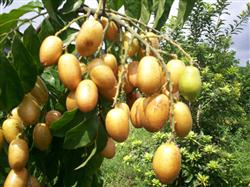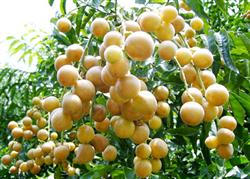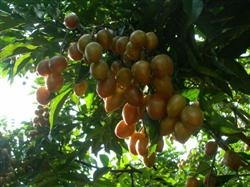How to grow the yellow skin of chicken heart?

How to grow the yellow skin of chicken heart? Please guide the cultivation of chicken heart yellow skin can refer to the following methods: first, the main cultivated varieties. At present, the main cultivated varieties are chicken heart yellow skin, selected big chicken heart yellow skin and so on. 2. Requirements of wampee to environmental conditions ⑴ temperature: the area where the annual average temperature is more than 20 ℃ and the average temperature in January is more than 12 ℃ is the most suitable. Adult trees will suffer frost injury when the temperature is below 0 ℃, and the cold tolerance of young trees is poor. ⑵ moisture: wampee is an annual evergreen fruit tree, which needs moist environment and sufficient water. It grows well in areas with more than 1500 mm annual rainfall and uniform distribution. Too much water or too concentrated rainfall is disadvantageous to wampee growth, development, flowering and fruiting. ⑶ light: sufficient light, canopy branches and leaves can absorb scattered light for photosynthesis, expand photosynthetic area, enhance tree nutrient accumulation, expand fruit area, improve fruit quality and yield; lack of light affects plant photosynthesis and nutrient accumulation, which is disadvantageous to plant growth and development. ⑷ soil: yellow bark does not have high requirements for soil, clay loam and sandy loam can be planted, but different soils will have different effects on wampee plant life and yield. When planted on sandy loam soil with good drainage, fertile soil and deep soil layer, the tree is strong, long-lived, high and stable yield; if you plant wampee on the clayey soil with thin soil, poor drainage and irrigation and stagnant water, the life span of wampee is short and the yield is low. Third, planting technology ⑴ planting time: generally carried out from March to May, when there are more Rain Water, the temperature rises, it is easy to take root, and the plant survival rate is high. When the nutrition bag seedlings are transplanted, the root system is less affected, and the garden with irrigation conditions can be planted in spring, summer, autumn and winter. ⑵ 2. Planting density: generally planting 50-80 plants per mu, and the row spacing can be 3m × 4m or 2.5m × 3.5m. When close planting is planned, about 110 plants will be planted per mu, and the row spacing can be 2 meters × 3 meters. Dig holes according to the specification of 1 meter long, 1 meter wide and 0.8 meters deep. Each hole should be buried with 50 kg of green manure, 50 kg of soil fertilizer, 500 grams of lime and 500 grams of phosphate fertilizer, and the backfilled topsoil should be about 20 cm higher than the ground. ⑶ planting: when planting, the roots of wampee seedlings should avoid contact with fertilizer, the seedlings should remain upright, the roots should stretch naturally around, and the depth should be fine soil to cover the seedlings to the root neck. 4. Management techniques of young trees (1) Fertilizer and water management ⑴ fertilization: young trees have not yet developed roots, shallow distribution, weak absorption, fertilization should grasp the principle of frequent and thin application, mainly nitrogen fertilizer, combined application of phosphate fertilizer, potash fertilizer, calcium fertilizer, magnesium fertilizer, foliar micro-fertilizer and so on. Fertilization can be started one month after the planting survived, and then fertilized before each shoot sprouting and after turning green. In addition, organic fertilizer should be applied deeply every winter. ⑵ water management: young trees grow vigorously, and their roots are shallow and few, so they are easily affected by the changes of soil moisture. It is necessary to strengthen soil moisture management, irrigation during drought and drainage during waterlogging, so as to keep the soil moist so as to facilitate the normal growth of plants. (2) soil management ⑴ loosening soil: young orchards with yellow bark should loosen the soil many times a year, usually combined with weeding and intercropping crops. In summer and autumn, loosen the soil after rain to prevent soil from hardening. The depth of loosening soil around the rhizosphere should be 5-10 cm. ⑵ soil improvement: generally starting from the second year after planting, ring-shaped ditches are opened around the original planting holes, or between rows (between plants), a strip of trenches are dug, 40-50 cm deep and 30 cm wide. Layer-by-layer application of forage, crop stalks, garbage and appropriate amount of lime, etc., rotation position every year, in 2-3 years, the whole garden deep turn to improve soil once. (3) shaping and pruning: after the seedlings are planted and survived, they are coring or truncated at the height of 40-50 cm of the main stem to promote bud germination under the section. After the main branch is ripe, coring or cutting is carried out at 15-20 cm to promote the bud germination under the shearing mouth, and then 2-3 robust and reasonably distributed branches are selected on each main branch to cultivate the secondary main branch. the third and fourth branches were cultured by the same method. (4) intercropping: young wampee orchards can use interrow planting of leguminous crops, such as peanuts, soybeans or vegetables, without affecting the growth of wampee, so as to protect the soil from moisture and heat. 5. Management techniques of fruiting trees (1) fertilization of fruiting trees ⑴ the first fertilization: after fruit harvest, the amount of fertilizer applied is relatively large, and the specific amount of fertilizer application depends on the age of fruiting trees, the amount of fruit and soil conditions. Water and fertilizer is 10 times of mature bran water, 15 kg per plant, drenched in shallow trenches near the dripping line around the crown or directly on the tree plate. If applying dry fertilizer, choose ternary compound fertilizer (the ratio of nitrogen, phosphorus and potassium is 15:15:15) to apply 200,300g per plant or 200g of urea. The second fertilization of ⑵: after the autumn shoots germinated, the aim was to promote the autumn shoots to mature and to promote the secondary autumn shoots in time, and to culture the fruiting mother branches. Plant application of ternary compound fertilizer (the ratio of nitrogen, phosphorus and potassium is 15:15:15) 200300g. The third fertilization of ⑶: before and after Greater Cold, the aim was to promote flower bud differentiation and facilitate the development of floral organ and fruiting branch. Plant application of livestock manure 10 kg, bran cake 500 g, mushroom residue 10 kg, forage 15 kg, lime 250 g, according to a layer of fertilizer and a layer of soil buried in the hole, and then backfill the topsoil. The fourth fertilization of ⑷: after the full flowering stage, the aim is to supplement the nutrients consumed by flowering in time, promote flowers and fruits, and keep the leaves green. 150-200g compound fertilizer was applied to the plant. The fifth fertilization of ⑸: during the fruit expansion period, that is, after the physiological fruit drop. The aim is to promote fruit expansion, normal fruit development, increase yield, plant application of compound fertilizer 150-200g. (2) pruning and ⑴ pruning of fruiting mother branches in winter: combined with garden cleaning in winter, it is mainly to cut off dead branches, disease and insect branches, shade branches and weak branches, so as to ensure ventilation and light, reduce diseases and insect pests and unnecessary nutrient consumption in the following year, so as to facilitate photosynthesis, promote autumn shoot growth and flower bud differentiation, and lay the foundation for high yield in the following year. ⑵ growing season pruning: combined with fruit harvesting or timely retraction or truncation of fruiting mother branches to promote autumn shoots and cultivate robust fruiting mother branches. ⑶ cultivated strong fruiting mother branches. Applying fertilizer before and after fruit, timely chasing and replenishing fertilizer during the growth and development of autumn shoots, so as to promote the germination and sturdiness of fruiting mother branches. During the germination, growth and development of autumn shoots, the inspection of the occurrence of insect pests was strengthened. it was found that the insect pests were sprayed immediately to reduce the population density and reduce the occurrence of insect pests. (3) Flower thinning, fruit thinning, fruit protection ⑴ flower thinning: large panicles of yellow flowers, many florets, more than 1000 flowers per panicle, long flowering period, especially young trees, usually the florescence of the same spike can be as long as 15-20 days, the fruit setting rate is 3-6%, and the higher one is about 10%. Due to the long flowering period, it not only causes fruit drop, but also leads to different sizes and ripening periods of fruits in the same ear. In order to reduce the nutrient consumption of the tree and promote the flowering and maturity of the same panicle to be consistent, the method of properly thinning flowers or truncating the panicle can be adopted. That is, from flowering to blooming, the top spike should be cut off about 1 / 3 of the total amount. If the flower spike has leaflets, the leaflets should be removed at the same time. ⑵ fruit thinning: fruit thinning can increase the fruit, so that the fruit size and maturity tend to be the same. Fruit thinning can be carried out after physiological fruit drop, generally removing deformed fruit, disease and insect fruit, small fruit, and then according to plant growth and nutrition level, hanging fruit quantity, thinning dense fruit. ⑶ fruit protection: from fruit expansion to maturity, attention should be paid to insect control, disease prevention and fruit cracking prevention. During the period of fruit development, water is drenched and sprayed during drought and drained during waterlogging to keep the environment and soil moist. Pay attention to the inspection and control of diseases and insect pests that harm the fruit. It is not suitable to apply pesticides within one month before fruit picking. If there are diseases and insect pests, they should be removed in time to reduce the spread of diseases and insect pests. Click for more wampee planting techniques click to get more fruit planting techniques
- Prev

How to prevent and cure the cracked fruit of yellow skin?
How to plant and manage the yellow skin of chicken heart? Please guide the chicken heart yellow skin is the best quality variety of all yellow skin strains, because of its "big fruit, thick meat, sweet taste" and deeply welcomed by the majority of consumers. It is easy to cultivate and manage, has strong adaptability to various climatic factors and soil conditions, and is very suitable for cultivation and production in this area. 200...
- Next

How to control the main diseases and insect pests of wampee?
How to control the main diseases and insect pests of wampee? Please introduce the main diseases and insect pests of wampee can be controlled by the following methods: 1. Anthrax is a common disease in production, which can be infected in all growth stages, and it has occurred seriously from June to October in recent years. Prevention and control methods: scientific use of fertilizer and water, enhance the tree potential,.
Related
- Moge, come on! The staff of the peasant association in the producing area of cantaloupe were frightened when the crowd gathered.
- Causes and Solutions of low Fruit setting rate of Apple
- Symptoms and control measures of passion fruit virus disease
- Fruit growing lesson: how do apple orchards keep high yields?
- Can you build orchards in the mountains? What are the pros and cons?
- How to manage the coloring period of Crisson grape?
- This paper introduces the processing technology of two kinds of fig products.
- How much is a month for retired teachers in rural areas by 2020?
- How can strawberry planting increase sugar content? We should pay attention to management in many aspects.
- What are the cultivation techniques on how to improve the yield of golden fruit?

